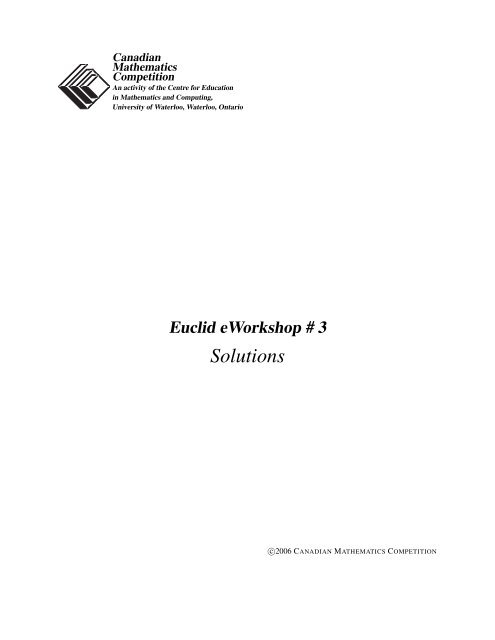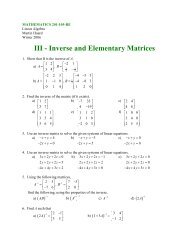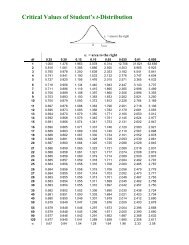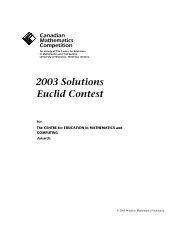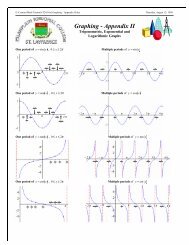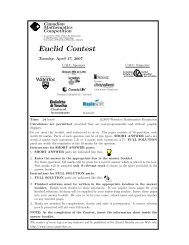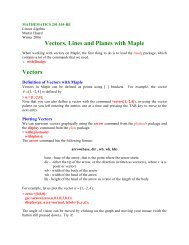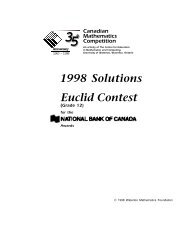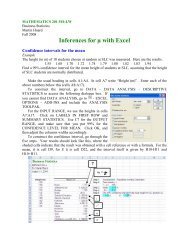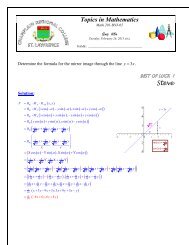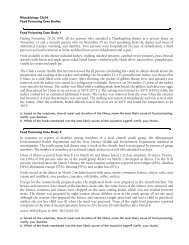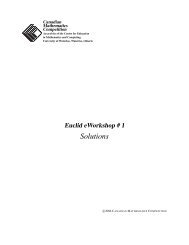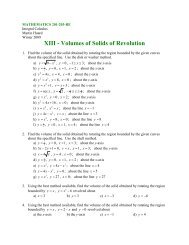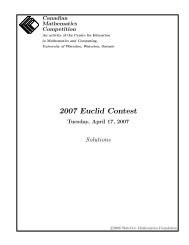view solutions - CEMC - University of Waterloo
view solutions - CEMC - University of Waterloo
view solutions - CEMC - University of Waterloo
You also want an ePaper? Increase the reach of your titles
YUMPU automatically turns print PDFs into web optimized ePapers that Google loves.
Canadian<br />
Mathematics<br />
Competition<br />
An activity <strong>of</strong> the Centre for Education<br />
in Mathematics and Computing,<br />
<strong>University</strong> <strong>of</strong> <strong>Waterloo</strong>, <strong>Waterloo</strong>, Ontario<br />
Euclid eWorkshop # 3<br />
Solutions<br />
c○2006 CANADIAN MATHEMATICS COMPETITION
Euclid eWorkshop #3<br />
SOLUTIONS<br />
SOLUTIONS<br />
1. Using the line segment from O(0, 0) to C(9, 0) as the base and noting the height is 4, the area <strong>of</strong> triangle OCD<br />
is 18. We let the vertical line be x = k. The line from O(0, 0) to D(8, 4) is y = 1 x and this intersects the<br />
2<br />
vertical line at K(k, 1/2k). Let L = (k, 0) be the x intercept <strong>of</strong> the vertical line. The area <strong>of</strong> triangle OKL<br />
must be 1 4 k2 = 9 and so the vertical line required is x = 6.<br />
2. There are several ways to do this question; we proceed using analytic geometry. If the line is tangent to the<br />
circle, then the distance from the centre (0,0) to the line y = x + c (or (x − y + c = 0)) equals the radius <strong>of</strong> the<br />
circle, 2 √ 2. Using the formula for distance from a point to a line in the toolkit,<br />
Therefore we have c = ±4.<br />
D = | Ax 0 + By 0 + C |<br />
√<br />
A2 + B 2<br />
2 √ 2 = | c | √<br />
2<br />
5<br />
4<br />
3<br />
2<br />
1<br />
0<br />
−5<br />
−4<br />
−3<br />
x<br />
−2<br />
−1 0<br />
−1<br />
1<br />
2<br />
3<br />
4<br />
5<br />
−2<br />
y<br />
−3<br />
−4<br />
−5<br />
3. There are two circles, the first with centre (0,0) and radius k, and the second with centre (5,−12) and radius<br />
7. The distance between the centres can be calculated to be √ (−5) 2 + (12) 2 = 13. Now if the two circles<br />
intersect only once, they can be either externally or internally tangent. If they are externally tangent, k + 7 = 13<br />
and k = 6. If they are internally tangent, | k − 7 |= 13 and k = 20 or −6. But the radius must be positive so<br />
k = 6 or 20.<br />
5<br />
20<br />
x<br />
16<br />
-5.0<br />
-2.5 0.0<br />
0<br />
2.5<br />
5.0<br />
7.5<br />
10.0<br />
12<br />
y<br />
6<br />
8<br />
-5<br />
4<br />
0<br />
y<br />
-10<br />
7<br />
-20 -10 0 6<br />
10<br />
-4<br />
x<br />
20<br />
-8<br />
7<br />
-15<br />
-12<br />
-16<br />
7<br />
-20<br />
CANADIAN MATHEMATICS COMPETITION 2
Euclid eWorkshop #3<br />
SOLUTIONS<br />
4. Solution 1: All lines that cut a circle in half pass through the centre. Now the perpendicular bisector <strong>of</strong> any<br />
chord passes through the centre. If we consider the vertical chord from (0,0) to (0,10), the perpendicular bisector<br />
is the horizontal line y = 5. Similarly if we consider the horizontal chord from (0,0) to (8,0), the perpendicular<br />
bisector is the vertical line x = 4. Therefore the centre is (4,5). We require the y intercept <strong>of</strong> the line through<br />
(4,5) and P (2, −3). This line is y = 4x − 11 and the intercept is −11.<br />
Solution 2: Observe that △AOB is right-angled at O, thus AB is the diameter <strong>of</strong> the circle, and its midpoint<br />
(4, 5) is the centre <strong>of</strong> the circle. As in solution 1, we require the y intercept <strong>of</strong> the line through (4,5) and<br />
P (2, −3). This line is y = 4x − 11 and the intercept is −11.<br />
10<br />
A<br />
5<br />
0<br />
B<br />
0.0<br />
P<br />
5<br />
10<br />
-5<br />
-10<br />
5. Since the slopes <strong>of</strong> AB and AC are 1 and −1 respectively, the required line is vertical and its equation is x = 0.<br />
6. The tangent is perpendicular to the radius at the point <strong>of</strong> tangency. The two known sides <strong>of</strong> the right triangle are<br />
the radius 2 and the segment from (0,0) to (3,4) which has length 5. Thus the tangents are <strong>of</strong> length √ 21.<br />
6<br />
5<br />
2<br />
y<br />
4<br />
3<br />
2<br />
2<br />
5<br />
1<br />
0<br />
-1<br />
0<br />
2<br />
x<br />
4<br />
6<br />
Since the tangent passes through the origin, let its equation be y = mx. We are interested in values <strong>of</strong> m for<br />
CANADIAN MATHEMATICS COMPETITION 3
Euclid eWorkshop #3<br />
SOLUTIONS<br />
which the line y = mx intersects the circle only once. Substituting into the equation <strong>of</strong> the circle we get<br />
(x − 3) 2 + (mx − 4) 2 = 4<br />
x 2 − 6x + 9 + m 2 x 2 − 8mx + 16 = 4<br />
(1 + m 2 )x 2 − (6 + 8m)x + 21 = 0<br />
Now this quadratic will have one solution when its discriminant its zero; we are looking for values <strong>of</strong> m that<br />
give a discriminant <strong>of</strong> 0.<br />
D = (6 + 8m) 2 − 4 · 21 · (1 + m 2 ) = 0<br />
36 + 96m + 64m 2 − 84 − 84m 2 = 0<br />
−20m 2 + 96m − 48 = 0<br />
m = 12 ± 2√ 21<br />
5<br />
7. The required set <strong>of</strong> points is the line that is the perpendicular bisector <strong>of</strong> the line segment CD. Since CD has<br />
a slope −1<br />
(3,<br />
2 and a midpoint M = 3 )<br />
, the required line passes through M and has slope 2. The resulting<br />
2<br />
equation is 4x − 2y − 9 = 0.<br />
8. We present the solution that uses analytic geometry most directly. Let the co-ordinates ( ) <strong>of</strong> the( points be K(0,0),<br />
x a + d<br />
W (x,y), A(a,b) and D(d,0). Therefore the co-ordinates <strong>of</strong> M and N are M<br />
2 ,y and N , b )<br />
. Now<br />
2 2 2<br />
we are given that 2MN = AW + DK. Therefore<br />
√ (a ) 2 ( ) 2 + d − x b − y<br />
2<br />
+ = d + √ (a − x)<br />
2<br />
2<br />
2 + (b − y) 2<br />
(a + d − x) 2 + (b − y) 2 = d 2 + (a − x) 2 + (b − y) 2 + 2d √ (a − x) 2 + (b − y) 2 after squaring<br />
2d(a − x) = 2d √ (a − x) 2 + (b − y) 2<br />
(a − x) 2 = (a − x) 2 + (b − y) 2 since d ≠ 0, squaring both sides<br />
(b − y) 2 = 0<br />
This result gives b = y and implies that the slope <strong>of</strong> AW = 0 and hence that AW is parallel to KD.<br />
9. If A(a,c) and B(b,d) then 4a + 3c − 48 = 0 and b + 3d + 10 = 0 since these points lie on each <strong>of</strong> the 2 lines.<br />
Moreover, since (4,2) is the midpoint, we know a + b = 4 and c + d = 2. Thus b = 8 − a and d = 4 − c,<br />
2<br />
2<br />
which together with the linear equations above, give A(6,8) and B(2,−4).<br />
CANADIAN MATHEMATICS COMPETITION 4


